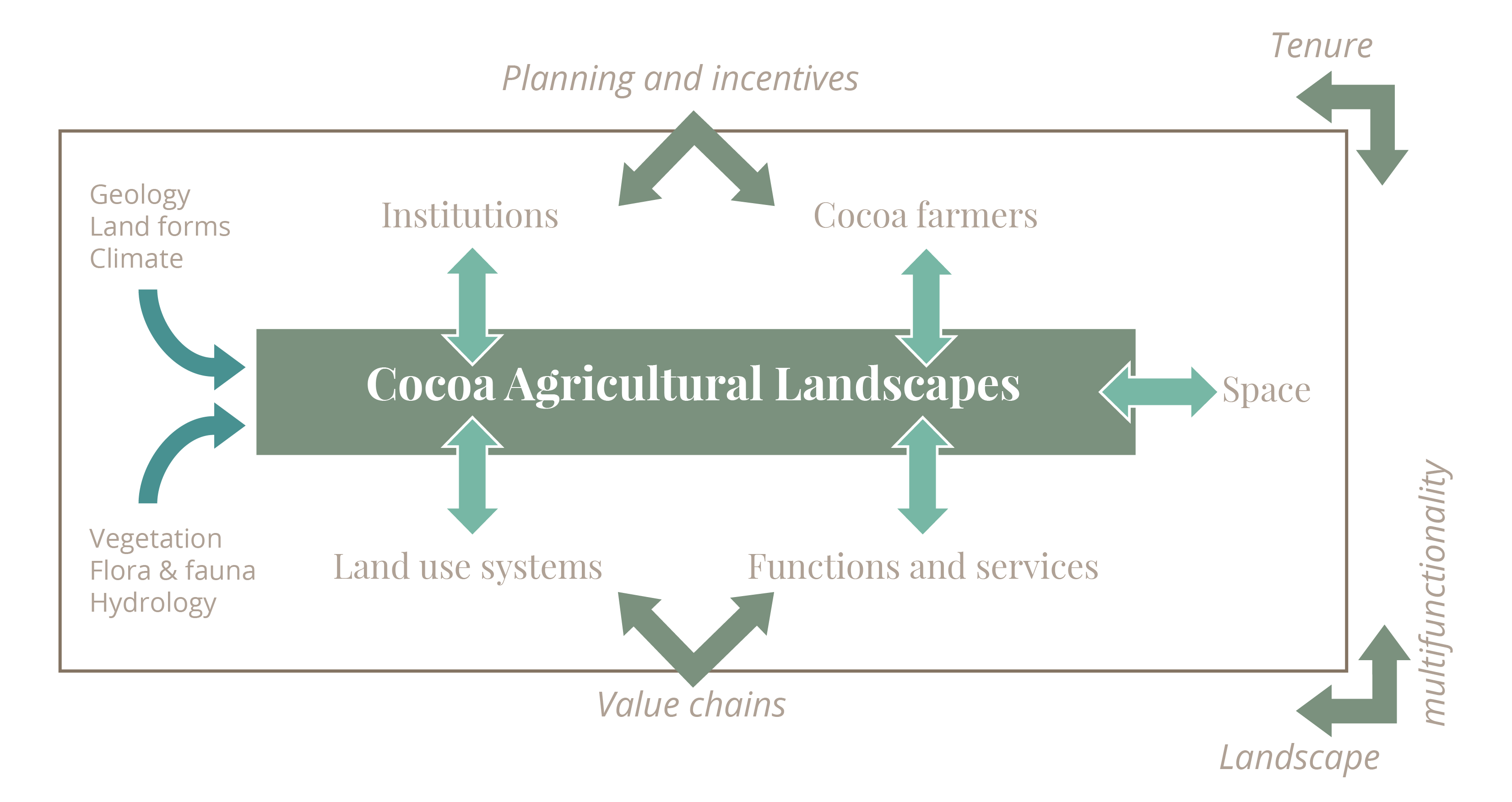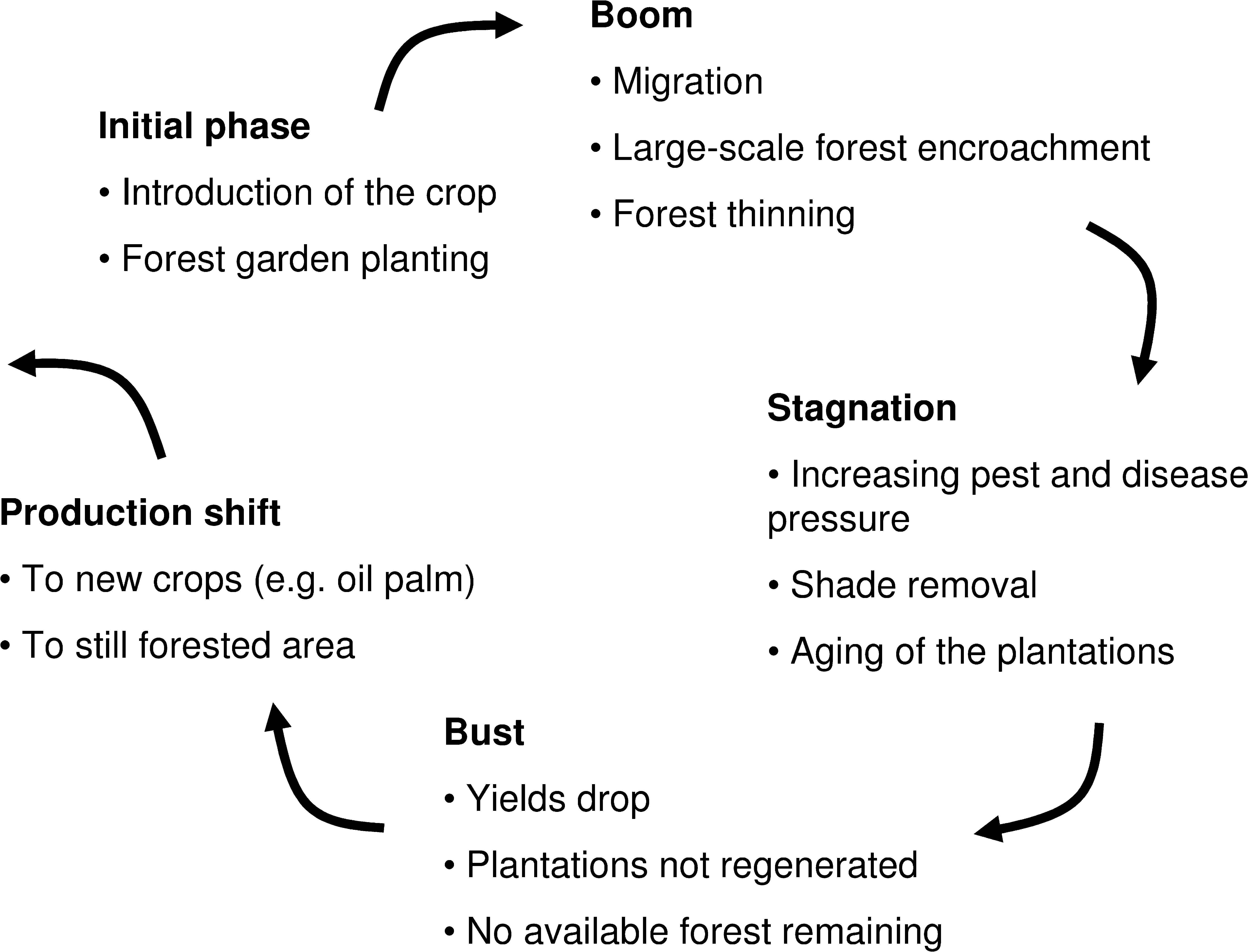Landscape management
Introduction
One of the defining issues in cocoa production is its effect on landscapes, specifically encroachment into forests. Landscapes can be defined as “area[s] large enough to produce vital ecosystem services, but small enough to be managed by the people using the land which produces those services” (FAO, 2013). The CSA Sourcebook of the FAO identifies structure, functions, and value as the components that describe an agricultural landscape. These concepts can be applied to briefly illustrate cocoa agricultural landscapes. In terms of structure, the original features of a landscape are transformed by the establishment of cocoa farms, most notably by the partial or complete cutting down of native tree species. Cocoa landscapes are multifunctional, they provide marketable products to farmers, but they also generate environmental services in the form of carbon sinks, among others. Considering that society values forestland and therefore governments set the boundaries of national parks and protected forest land, it follows that the greater the number of forest species within cocoa farms the higher their value. Nonetheless, the cost of maintaining landscape provisions that are valuable to society is often higher than what farmers can bear or have incentives to bear.

Figure: adapted from FAO (2013)
From a temporal perspective, cocoa agricultural landscapes are determined by the boom and bust cycle of cocoa plantations (Clough, et al. 2009). A forested area may become a cocoa agricultural landscape and experience a shift in production or abandonment within the span of 20 to 25 years. At the end of the life cycle of cocoa the regeneration of functions and services of the landscape takes additional time.
Cocoa boom and bust cycle (Clough, et al. 2009)
CSC caters to the yield increasing objectives of governments and farmers while reducing the negative environmental consequences of farming. In this sense, CSC falls in line with the description of sustainable agricultural intensification laid out by Pretty, et al. (2011) of “producing more output from the same area of land while reducing negative environmental impacts”. CSC, however, additionally accounts for the need of adaptation capacity to climate change thereby offering a more complete projection of the changes required for a sustainable agricultural landscape. Alemagi, et al. (2015) list the mitigation, adaptation, and developmental benefits of a sustainable intensification pathway of cocoa landscapes:
- Forest conservation and sequestration of CO2.
- Diversification of farmer incomes from timber and fruit producing tree species integrated in the cocoa farm.
- Shade trees improve soil fertility and consequently the productivity of cocoa trees.
- Fruit and timber species diversification can buffer the negative effects of income losses related to cocoa, improving farmer food security.
- Profitability increases gained from diversification reduce the need for forest land encroachment.
Importance in terms of CSC
Productivity: Landscape approaches increase productivity. Cocoa farms maintaining ecosystem services and forest connectivity. Barrier effects and amenable environments for natural enemies of cocoa pests are one of the ways in which landscapes approaches increase productivity.
Adaptation: Diversification in the landscape reduces risks from pests and diseases, and the negative impacts of climate change on cocoa plots. Moreover, farmers with diversified plots are less dependent on cocoa incomes.
Mitigation: Higher landscape diversification and adoption of cocoa agroforestry production systems increase carbon sequestration at the landscape level. The adoption of CSC practices further reduces GHG emissions (e.g. through mulching, instead of increasing fertilizer use.
Study cases
Case study 1: Ghana
Impact of cocoa farming on vegetation in an agricultural landscape in Ghana – Asase, et al. (2010)
Background
The authors study on the landscape effects of cocoa production establishment and gradual intensification in the Eastern Region of Ghana. Common crops intercropped with cocoa in this region include plantain, banana, cassava, maize, and cocoyam. The study was carried out between April of 2005 and October of 2006. The authors discuss results in terms of biodiversity, structural characteristics, and change in population species.
Relevance in terms of CSC
Asase, et al. (2010) identified significant losses in native forest species richness as the forest was gradually converted into an unshaded cocoa plantation. The mean density and basal area of other plants also decreased during this process. The authors argue that the ecological stress caused by indiscriminate land transformation to full-sun cocoa also has negative effects on cocoa trees making them more vulnerable to pests and diseases. The introduction of non-forest species like exotic fruit trees, other cash crops, and traditional agroforestry trees in agroforestry is an additional factor in landscape changes changing the floristic composition and ecology (Asare, et al. 2010) but cocoa agroforests are still preferred in terms of carbon sequestration (Silatsa, et al. 2016). Regarding biodiversity, shade trees increase forest connectivity facilitating the movement of animals and plant propagules (Asare, et al. 2010).
Case study 2: Cameroon
Pathways for sustainable intensification and diversification of cocoa agroforestry landscapes in Cameroon – Alemangi, et al. (2015)
Background
The authors provide and overview of four different cocoa agricultural landscapes: Dominant current practice, full-sun cocoa, tree intensified and diversified cocoa agroforestry systems, and cocoa enhancement and diversification through vegetative propagation. They proceed to discuss key practices involved in each and the merits of each in terms of the CSC goals of productivity, adaptation, and mitigation.
Relevance in terms of CSC
At the time of writing their article, the Alemagi, et al. (2015) noted that the government of Cameroon encouraged the expansion of full-sun production, a position that has been taken by other governments as well (Cassano, et al. 2009). This stance may be driven by the important role of cocoa exports in increasing the inflow of foreign currency. In Cameroon, for example, the export of cocoa makes up 15% of the total annual export revenue (Alemagi, et al. 2015). Large-scale conversion to full-sun cocoa production, however, is a short-sighted landscape approach when considering the negative environmental, biodiversity, and long-term productivity consequences. Low-shade/full-sun production systems are example of maladaptation in the cocoa agricultural landscape, i.e., these systems increases the vulnerability of farmers to environmental risks.
The direct and indirect promotion of specific approaches to cocoa farming alters landscapes and their characteristics, including their capacity of carbon storage. Alemagi, et al. (2015) compare the impact of four cocoa production scenarios on landscapes and CSA objectives in Cameroon. The first scenario describes current practices: the planting of cocoa alongside fruit and timber tree species. Cocoa productivity is low, but there are typically nine additional tree species and between 26 and 33 herbaceous species. Carbon sequestration per ha is over 100 tonnes in these systems. The second scenario, full-sun cocoa, has very high yields (almost three times as much production per ha than the previous scenario) but at the cost of on-farm species richness and carbon sequestration capacity (a 35% to 48% decrease with respect to the current practices scenario). The last two scenarios, namely, tree intensified and diversified cocoa agroforestry systems and cocoa enhancement and diversification through vegetative propagation, can be a considered a middle ground of the ones already described in terms of biodiversity, carbon sequestration, and cocoa yields.

